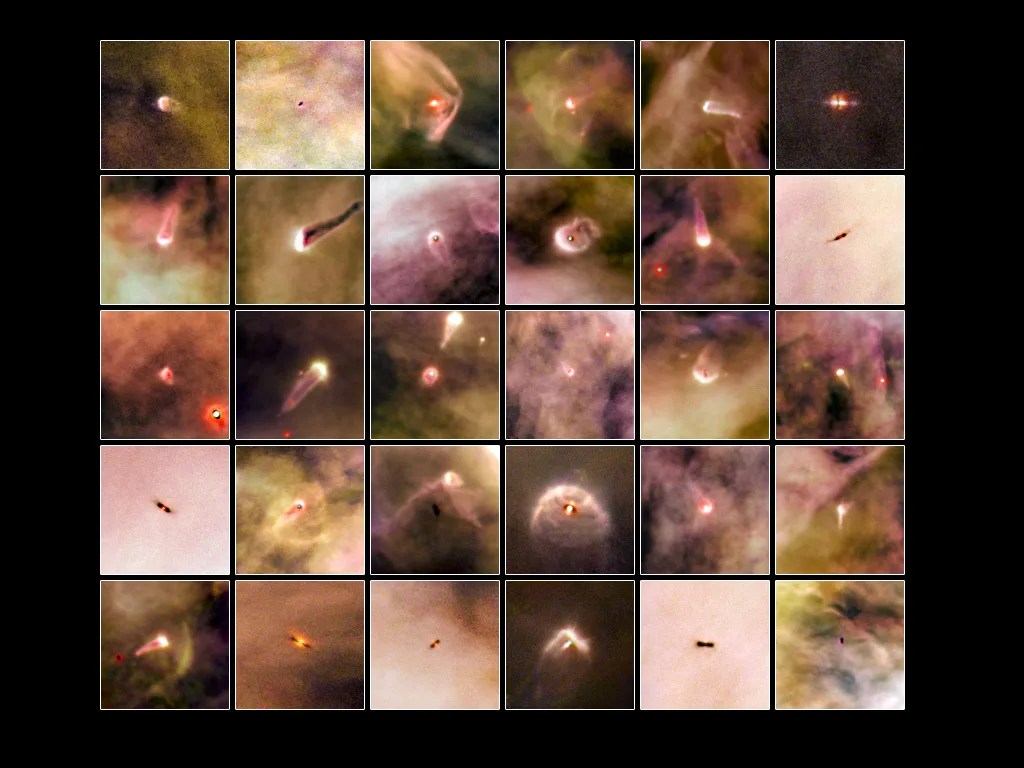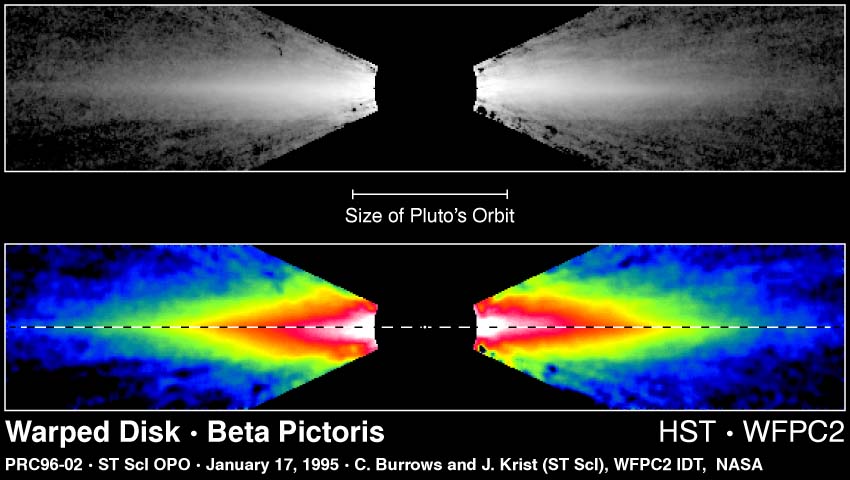In 1992, Hubble was the first telescope to resolve protoplanetary disks (dubbed “proplyds”) around stars in the Orion Nebula. Protoplanetary disks are dense gas and dust disks surrounding newly formed stars. Hubble’s high resolution and sensitivity, along with the Orion Nebula’s proximity, have allowed the telescope to image proplyds around nearly 200 stars in the nebula. Proplyds are pancake-like disks of mostly gas and some dust surrounding a young star. They are a prerequisite for the formation of planetary systems.
Hubble also completed the largest and most sensitive visible-light imaging survey of debris disks around stars. Debris disks are belts of dust and rubble that form when objects like asteroids and comets collide. Astronomers use them as “planet detectors.” Two particular stars highlight Hubble’s observations: TW Hydrae and Beta Pictoris.
-
TW Haydrae Protoplanetary Disk
Using a mask to block the star’s bright light, Hubble scientists spotted a mysterious gap in a vast protoplanetary disk of gas and dust swirling around the star TW Hydrae. The gap is likely the result of a growing, unseen planet gravitationally sweeping up material and carving out a lane in the disk like a snowplow. The 1.9-billion-mile-wide (3 billion km) gap isn’t completely cleared of material yet.
Hubble Uncovers Evidence for Extrasolar Planet Under Construction
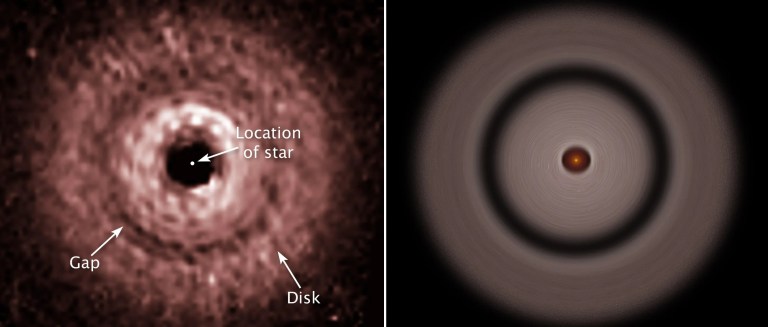 This Hubble image (left) and graphic (right) show a gap in a protoplanetary disk of dust and gas whirling around the nearby red dwarf star TW Hydrae.NASA, ESA, J. Debes (STScI), H. Jang-Condell (University of Wyoming), A. Weinberger (Carnegie Institution of Washington), A. Roberge (Goddard Space Flight Center), G. Schneider (University of Arizona/Steward Observatory) and A. Feild (STScI/AURA)
This Hubble image (left) and graphic (right) show a gap in a protoplanetary disk of dust and gas whirling around the nearby red dwarf star TW Hydrae.NASA, ESA, J. Debes (STScI), H. Jang-Condell (University of Wyoming), A. Weinberger (Carnegie Institution of Washington), A. Roberge (Goddard Space Flight Center), G. Schneider (University of Arizona/Steward Observatory) and A. Feild (STScI/AURA) -
Shadow on TW Hydrae's Disk
More recently, astronomers using Hubble noticed a change in brightness with position in TW Hydrae's disk. Because Hubble has 18 years' worth of observations of the star, the astronomers could assemble a time-lapse movie of the shadow's rotation. They think an unseen planet in the disk is gravitationally pulling on material near the star and warping the inner part of the disk. The twisted, misaligned inner disk is casting its shadow across the surface of the outer disk.
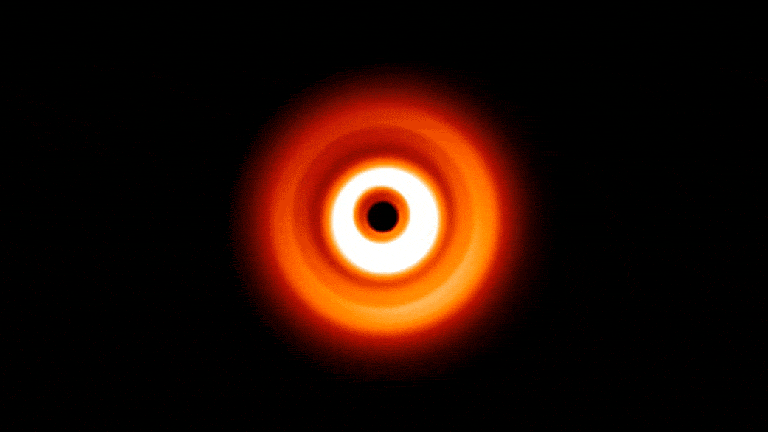 This animation compiles images taken a year apart by NASA’s Hubble Space Telescope, which reveal a shadow moving counterclockwise around a gas-and-dust disk encircling the young star TW Hydrae.NASA/ESA/J. Debes (STScI)
This animation compiles images taken a year apart by NASA’s Hubble Space Telescope, which reveal a shadow moving counterclockwise around a gas-and-dust disk encircling the young star TW Hydrae.NASA/ESA/J. Debes (STScI)

Beta Pictoris Planetary Disk
Hubble’s longevity also allowed researchers to chart changes in the disk surrounding the 20-million-year-old star Beta Pictoris. In 1998, Hubble’s visible-light views of the edge-on disk revealed undulations that computer models suggested were gravitational evidence of budding planets and possibly a companion brown dwarf or bypassing star. Roughly 10 years after Hubble’s observations, astronomers directly imaged a gas giant planet in the disk, still glowing from its recent formation.
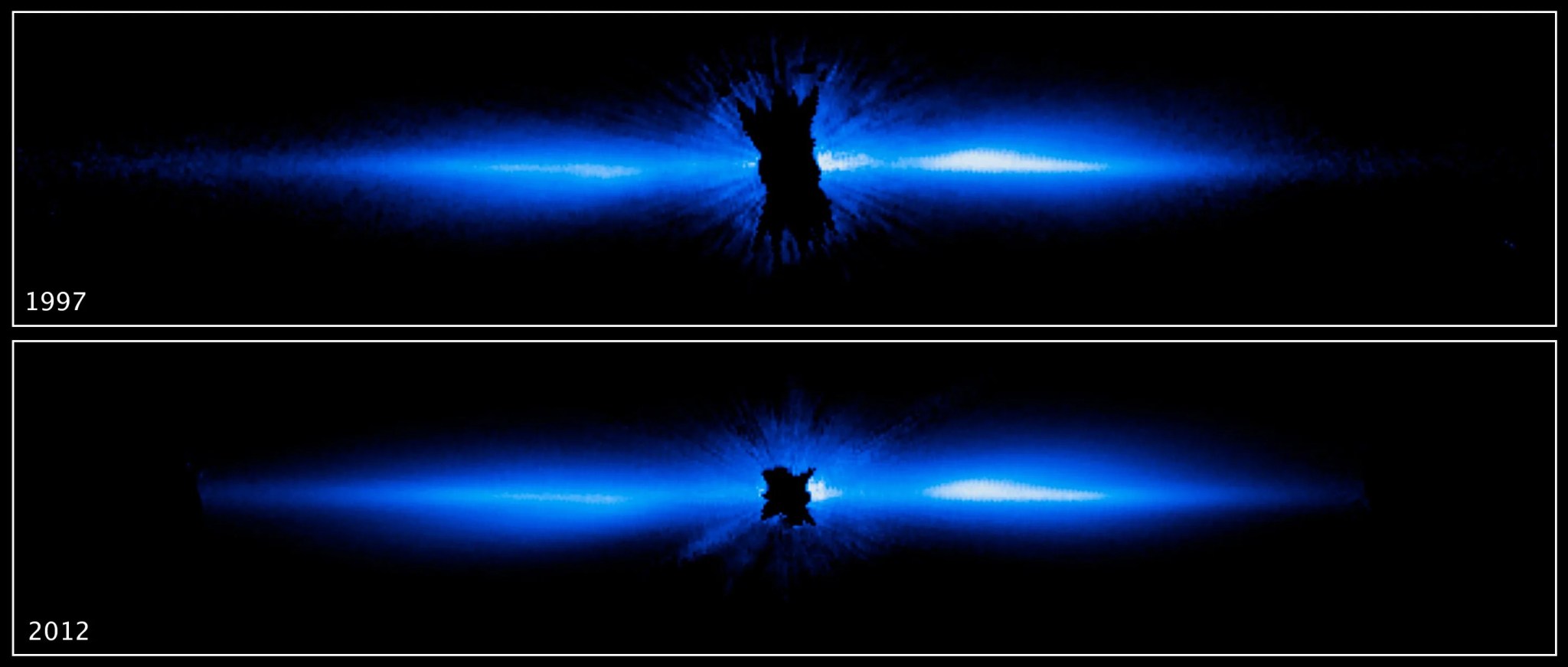
The blue Hubble image traces the disk to within 650 million miles (one billion km) of the star, a distance that would be the radius of Saturn's orbit about the Sun. Astronomers have uncovered at least two young planets around Beta Pictoris, and Hubble’s ground-breaking observations of the disk contributed greatly to those discoveries.
-
An Asymmetric Dust Disk
Hubble also captured a vast and complex dust structure extending some 150 billion miles (240 billion km) across, enveloping the young, 8-million-year-old star HR 4796A. The bright ring, about 7 billion miles (11 billion km) from the star, is a debris field of very fine dust that is likely the result of developing planets colliding near the star. Light pressure from the star, which is 23 times more luminous than the Sun, expelled the dust far into space. The wider debris field is much more extended in one direction than the other. This may be due to the star’s motion through space, or it may be the result of a gravitational tug from the star’s binary companion, a red dwarf star (HR 4796B) at least 54 billion miles (87 billion km) from HR 4796A.
Hubble Finds Huge System of Dusty Material Enveloping the Young Star HR 4796A
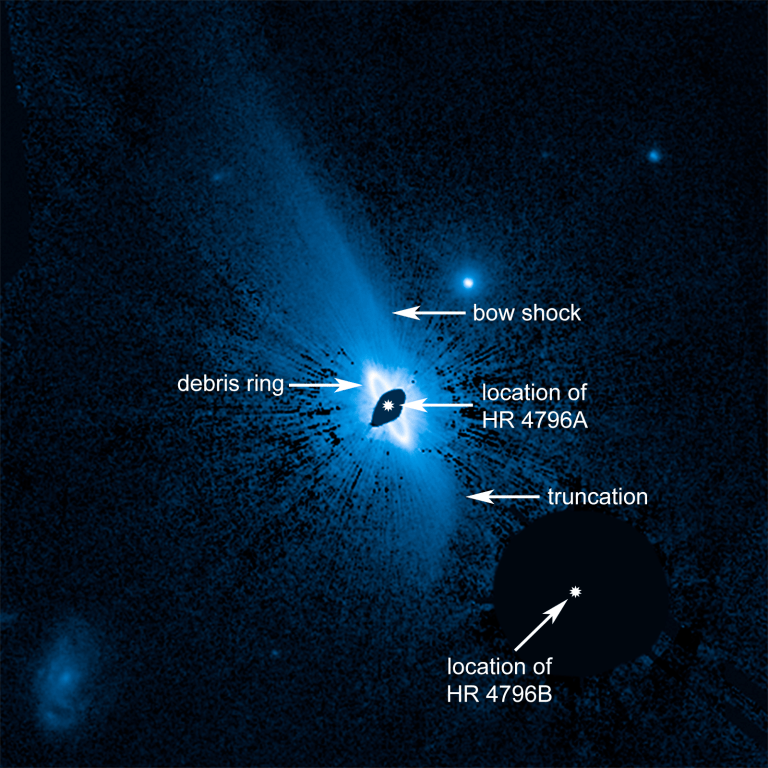 HR 4796ANASA/ESA/G. Schneider (Univ. of Arizona)
HR 4796ANASA/ESA/G. Schneider (Univ. of Arizona) -
Protoplanet around PDS 70b
Hubble was the first observatory to image a forming planet (PDS 70b) in ultraviolet light (UV). Hubble’s unique UV capabilities gave planetary scientists the first opportunity to witness extremely hot gas falling onto the planet. The Jupiter-sized world is slowly accumulating matter, allowing researchers to estimate how fast the planet is gaining mass. Located 370 light-years from Earth, the remote planet took about 5 million years to grow to its present size of up to five times the mass of Jupiter. If PDS 70b’s accretion rate remains steady for another million years, the planet would only grow by roughly 1/100th of a Jupiter mass.
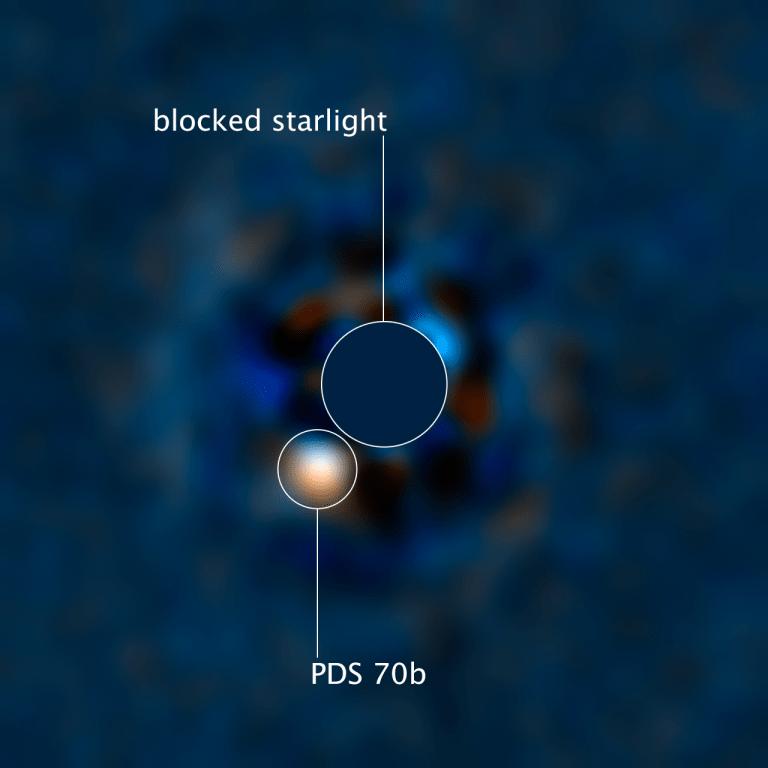 Hubble observations pinpoint planet PDS 70b. A coronagraph on Hubble’s camera blocks out the glare of the central star for the planet to be directly observed.NASA, ESA, McDonald Observatory–University of Texas, Yifan Zhou (UT); Image Processing: Joseph DePasquale (STScI)
Hubble observations pinpoint planet PDS 70b. A coronagraph on Hubble’s camera blocks out the glare of the central star for the planet to be directly observed.NASA, ESA, McDonald Observatory–University of Texas, Yifan Zhou (UT); Image Processing: Joseph DePasquale (STScI) -
AB Aurigae b
Hubble's longevity and high resolution also came into play when its Space Telescope Imaging Spectrograph (STIS) and its Near Infrared Camera and Multi-Object Spectrograph (NICMOS) directly imaged another forming Jupiter-like protoplanet, called AB Aurigae b, over a 13-year span. Hubble captured the growing exoplanet embedded in a disk that has distinct spiral structures swirling around the young star AB Auriagae. The planet is about nine times more massive than Jupiter and orbits some 8.6 billion miles (13.6 billion km) from the star – over two times farther than Pluto is from the Sun.
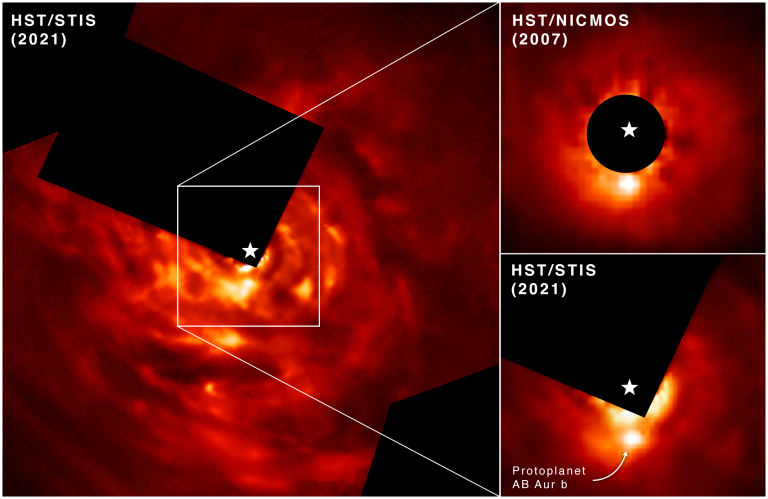 In the top right, Hubble’s Near Infrared Camera and Multi-Object Spectrograph image captured in 2007 shows AB Aurigae b in a due south position compared to its host star, which is covered by the instrument’s coronagraph. The image captured in 2021 by Hubble's Space Telescope Imaging Spectrograph shows the protoplanet has moved in a counterclockwise motion over time.Science: NASA, ESA, Thayne Currie (Subaru Telescope, Eureka Scientific Inc.); Image Processing: Thayne Currie (Subaru Telescope, Eureka Scientific Inc.), Alyssa Pagan (STScI)
In the top right, Hubble’s Near Infrared Camera and Multi-Object Spectrograph image captured in 2007 shows AB Aurigae b in a due south position compared to its host star, which is covered by the instrument’s coronagraph. The image captured in 2021 by Hubble's Space Telescope Imaging Spectrograph shows the protoplanet has moved in a counterclockwise motion over time.Science: NASA, ESA, Thayne Currie (Subaru Telescope, Eureka Scientific Inc.); Image Processing: Thayne Currie (Subaru Telescope, Eureka Scientific Inc.), Alyssa Pagan (STScI) -
Vega’s Surprisingly Smooth Dust Disk
More recently, researchers used the combined power of Hubble and Webb to study the 100-billion-mile-diameter (160 billion km) debris field around the star Vega. They were surprised to find Vega’s disk looking smooth with no obvious evidence for large planets plowing through the disk, which is common around other young stars. Hubble sees debris the size of smoke particles, and Webb traces roughly sand-grain-sized particles closer to the star.
NASA’s Hubble, Webb Probe Surprisingly Smooth Disk Around Vega
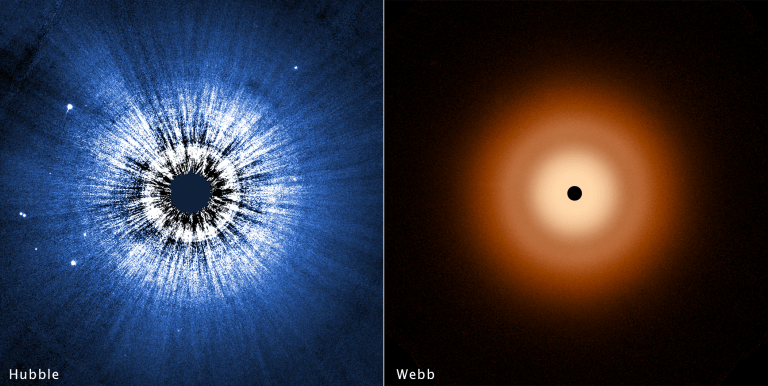 Vega's Dust DiskNASA, ESA, CSA, STScI, S. Wolff (University of Arizona), K. Su (University of Arizona), A. Gáspár (University of Arizona)
Vega's Dust DiskNASA, ESA, CSA, STScI, S. Wolff (University of Arizona), K. Su (University of Arizona), A. Gáspár (University of Arizona)
Learn More

Hubble Gets Best View of a Circumstellar Debris Disk Distorted by a Planet
When comparing the latest Hubble images to those taken in 1997, astronomers find that the disk's dust distribution has barely changed over 15 years despite the fact that the entire structure is orbiting the star like a carousel.
Hubble Science Highlights
Discover the breadth and depth of Hubble's exciting discoveries!
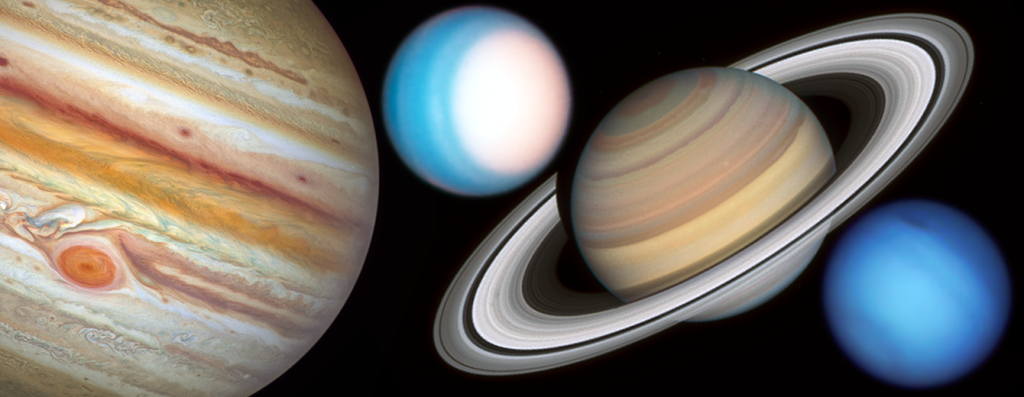
Studying the Planets and Moons
Hubble’s systematic observations chart the ever-changing environments of our solar system's planets and their moons.
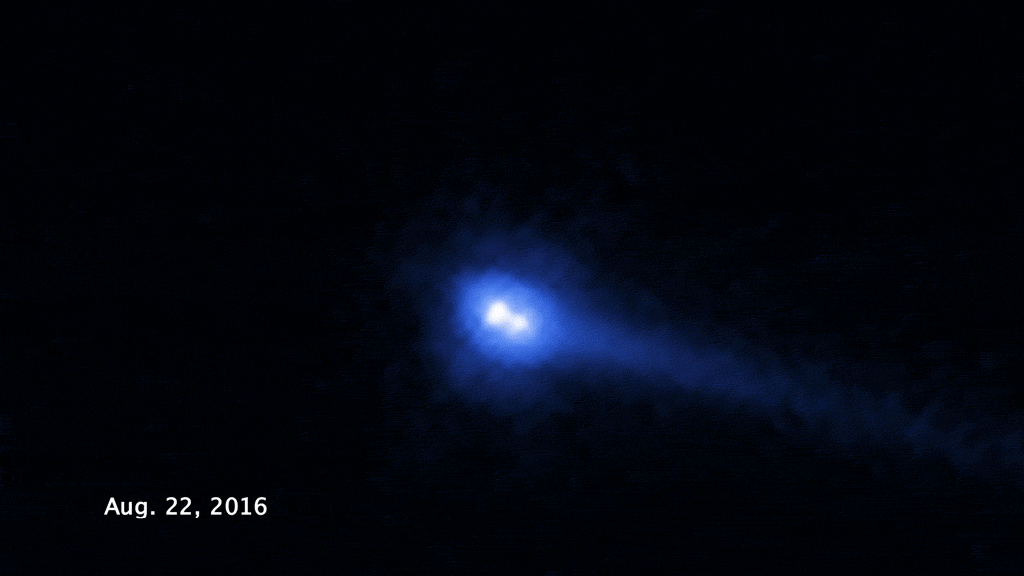
Tracking Evolution in the Asteroid Belt
These conglomerates of rock and ice may hold clues to the early solar system.
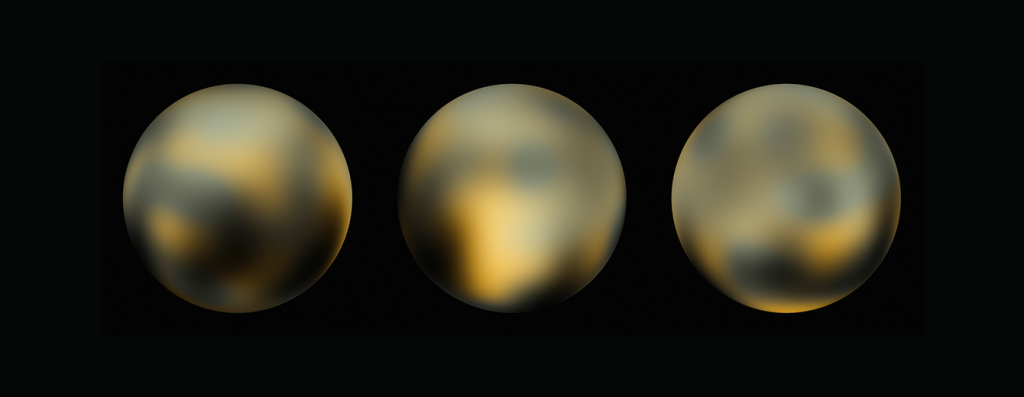
Uncovering Icy Objects in the Kuiper Belt
Hubble’s discoveries helped NASA plan the New Horizon spacecraft’s flyby of Pluto and beyond.
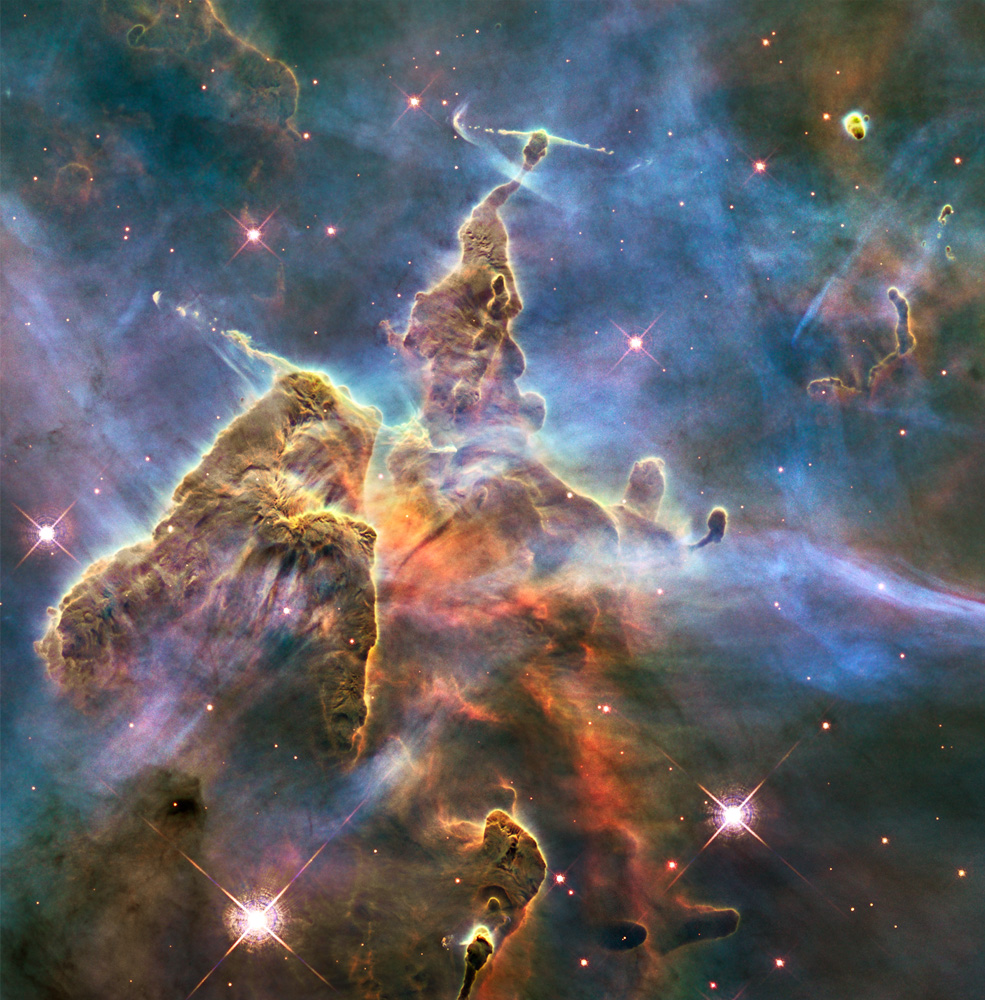
Exploring the Birth of Stars
Seeing ultraviolet, visible, and near-infrared light helps Hubble uncover the mysteries of star formation.
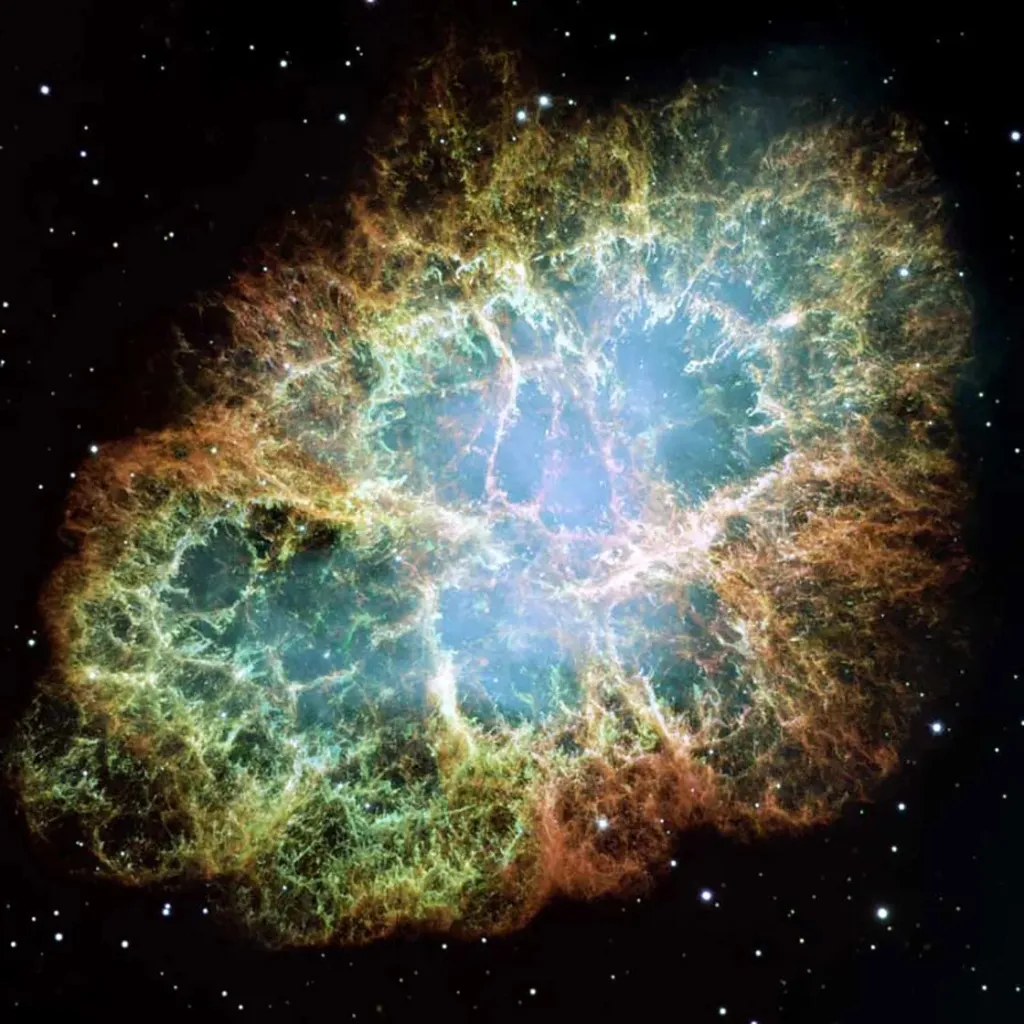
The Death Throes of Stars
When stars die, they throw off their outer layers, creating the clouds that birth new stars.
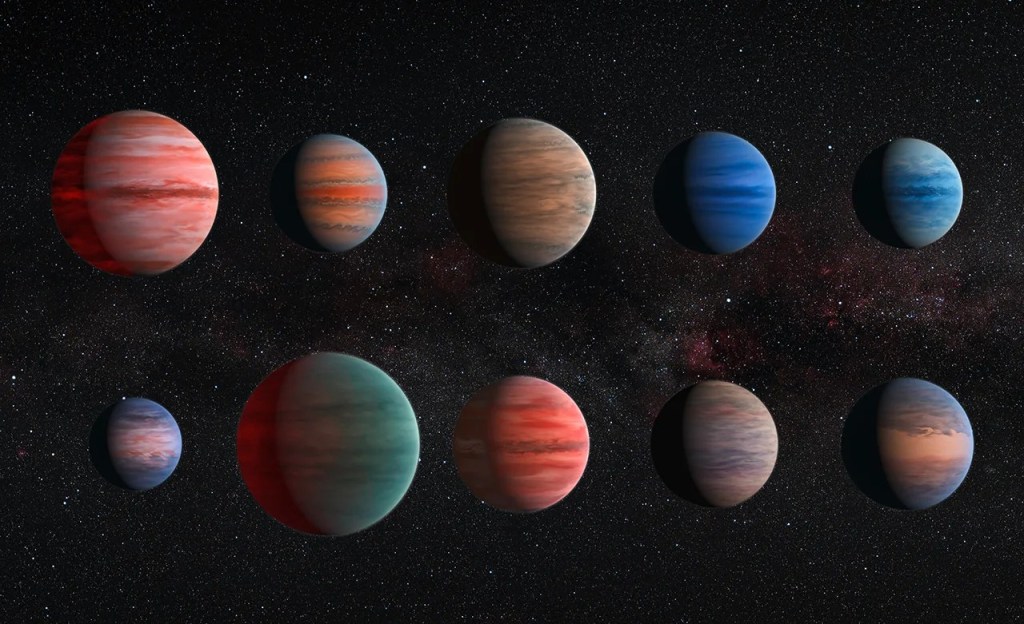
Recognizing Worlds Beyond Our Sun
Hubble can detect and measure the basic organic components for life on planets orbiting other stars
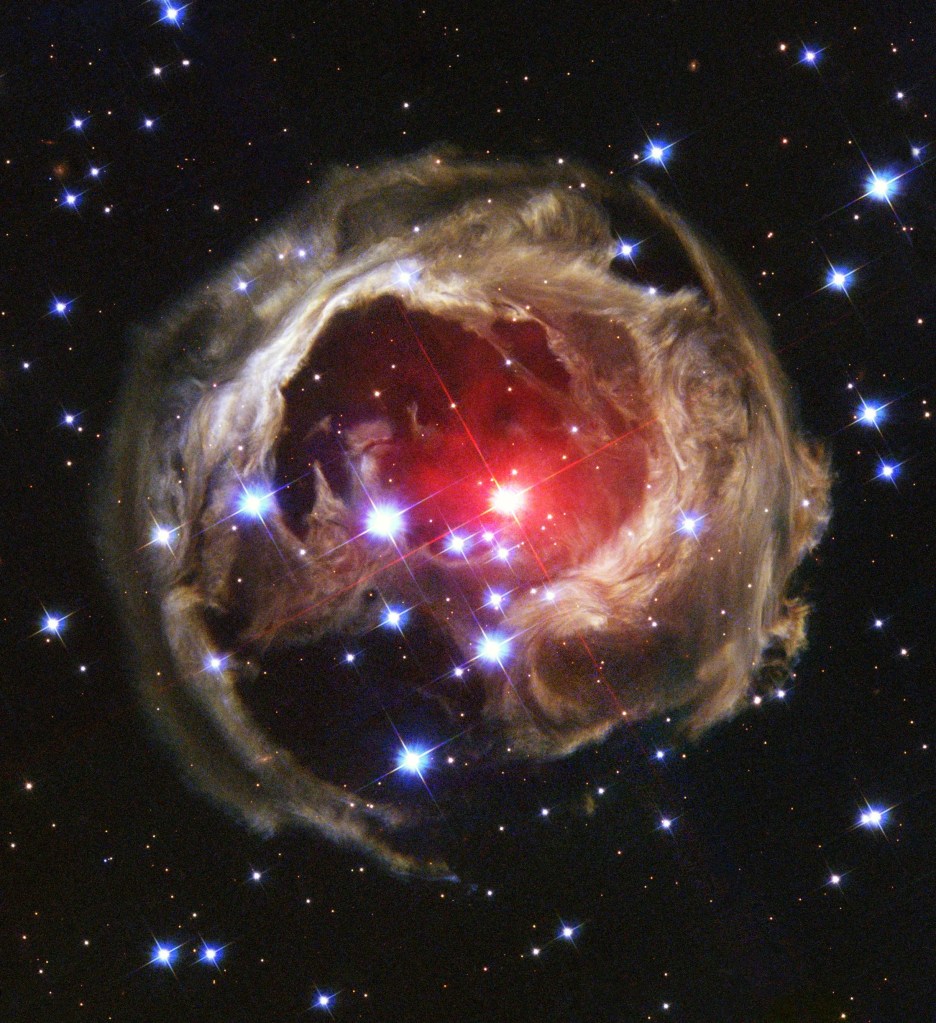
Seeing Light Echoes
Like ripples on a pond, pulses of light reverberate through cosmic clouds forming echoes of light.
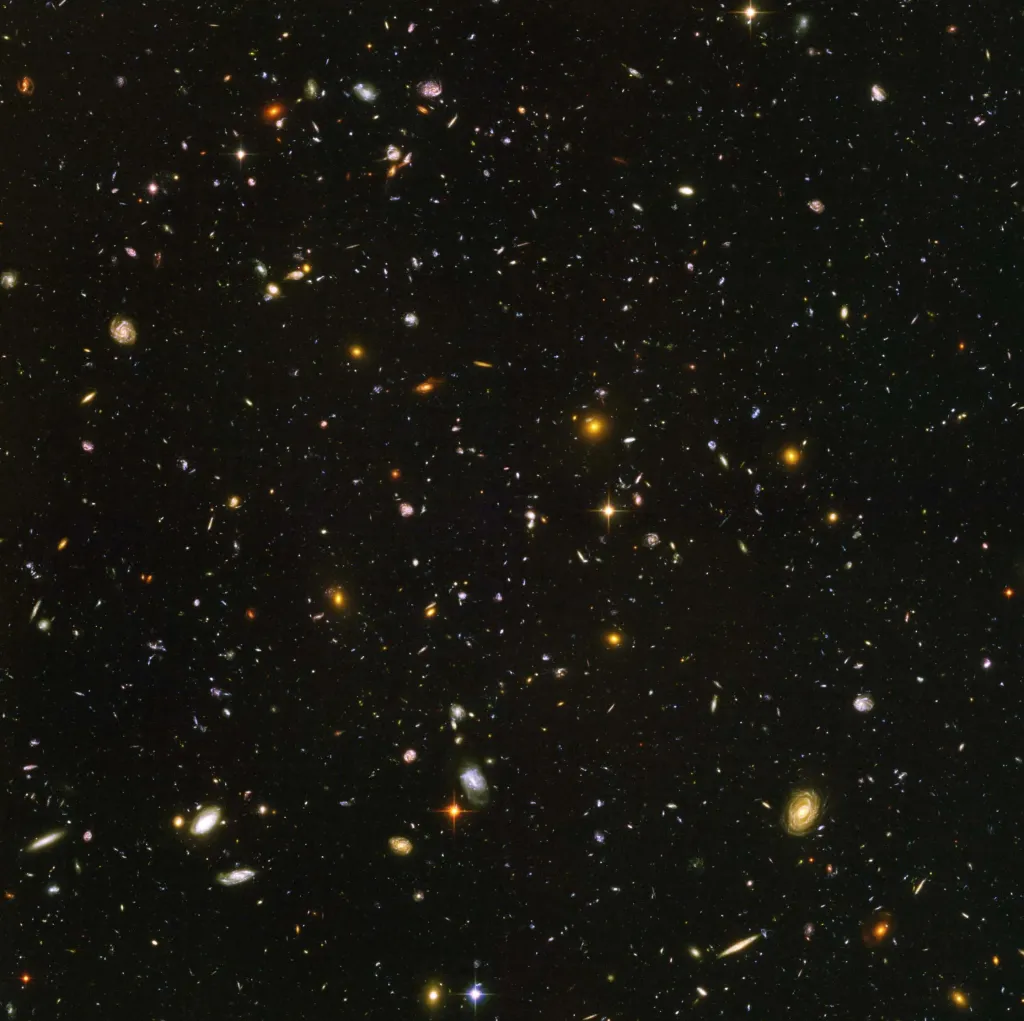
Tracing the Growth of Galaxies
Hubble's Deep Field observations are instrumental in tracing the growth of galaxies.
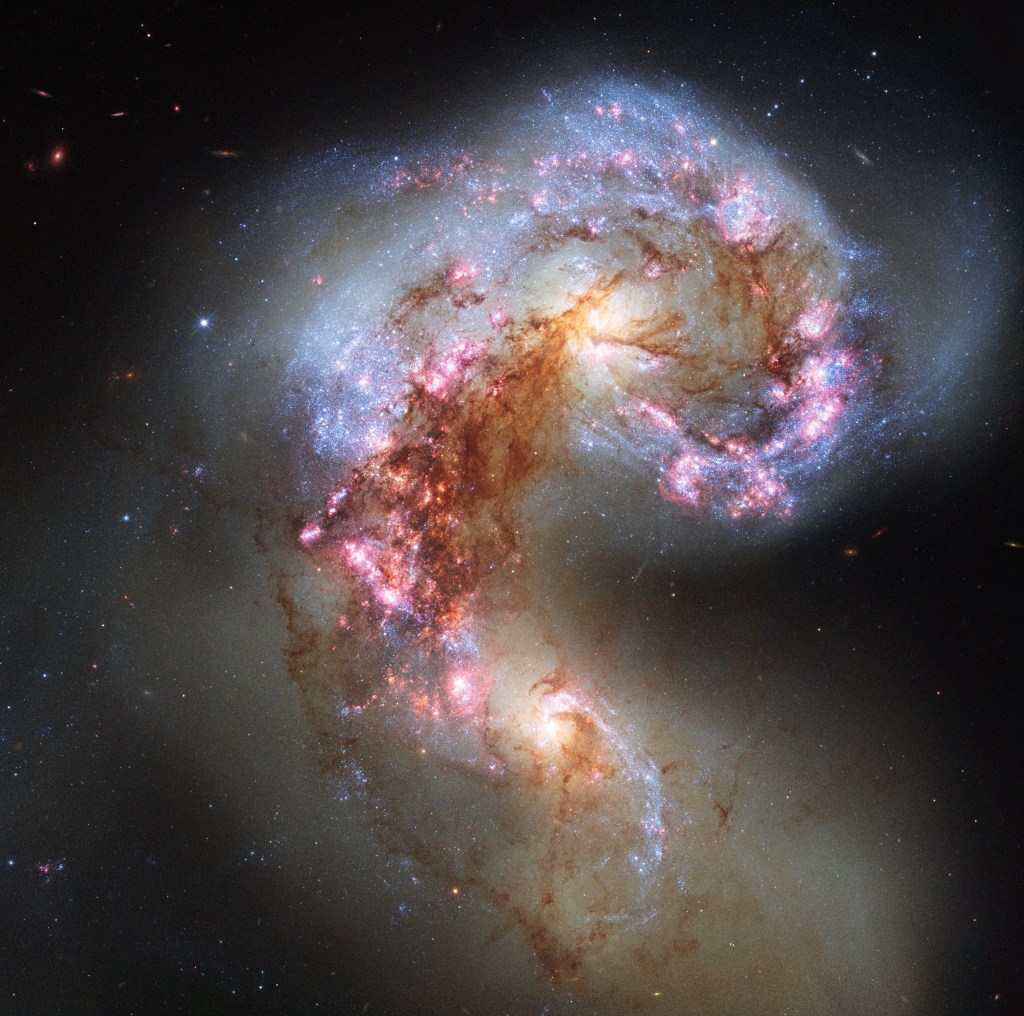
Galaxy Details and Mergers
Galaxies evolve through gravitational interaction with their neighbors, creating a menagerie of forms.
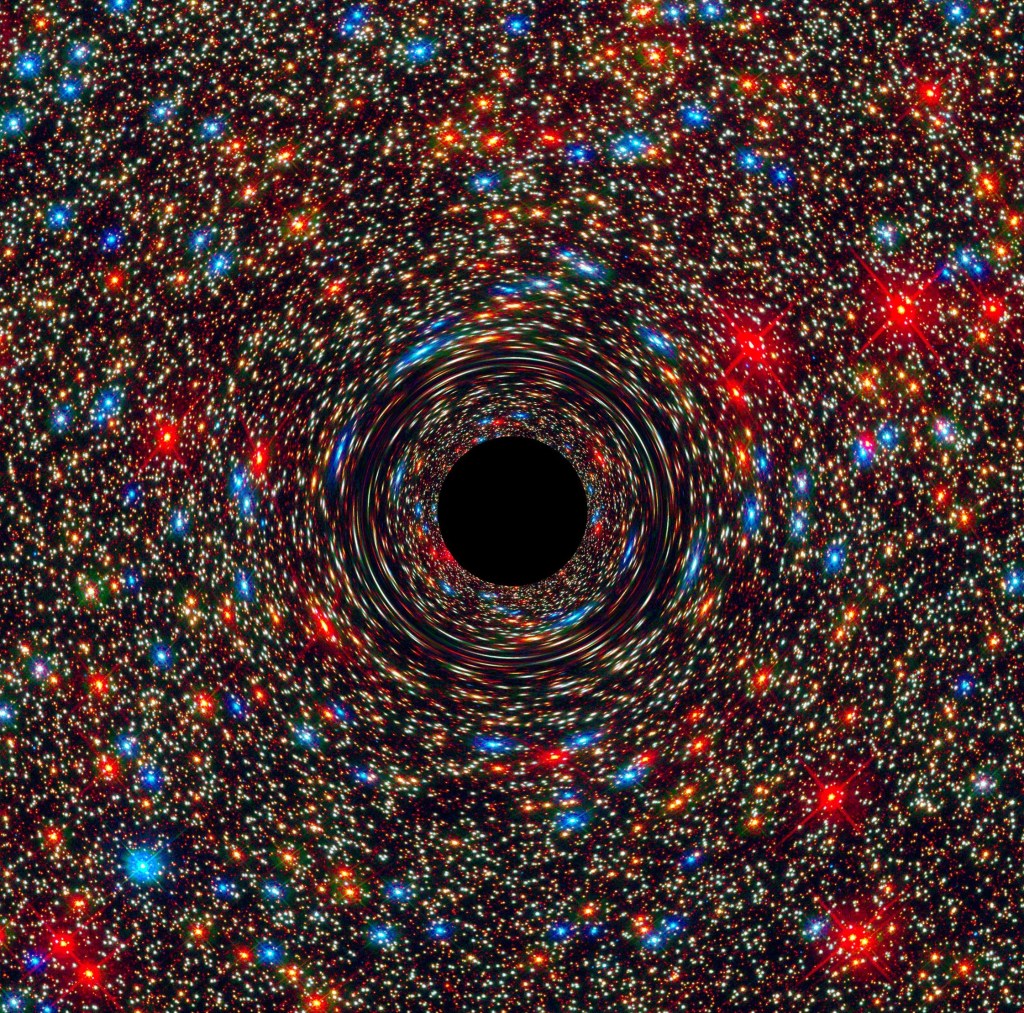
Monster Black Holes are Everywhere
Supermassive black holes lie at the heart of nearly every galaxy.

Homing in on Cosmic Explosions
Hubble helps astronomers better understand and define some of the largest explosions in the universe.
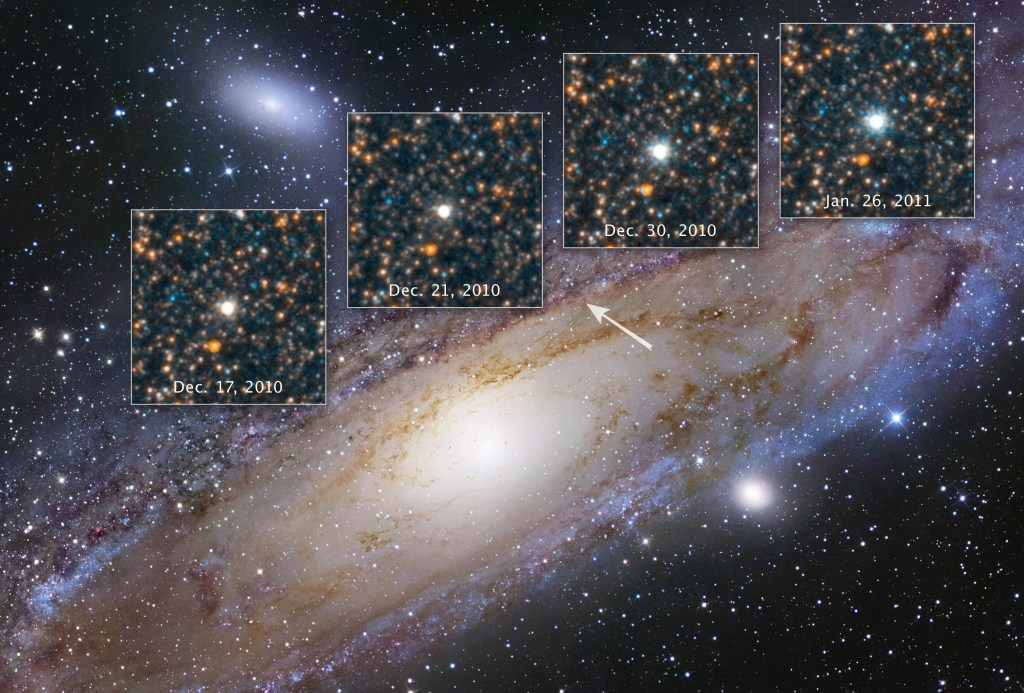
Discovering the Runaway Universe
Our cosmos is growing, and that expansion rate is accelerating.

Focusing in on Gravitational Lenses
Gravitational lenses are 'Nature's Boost', expanding our view deeper into space and farther back in time.
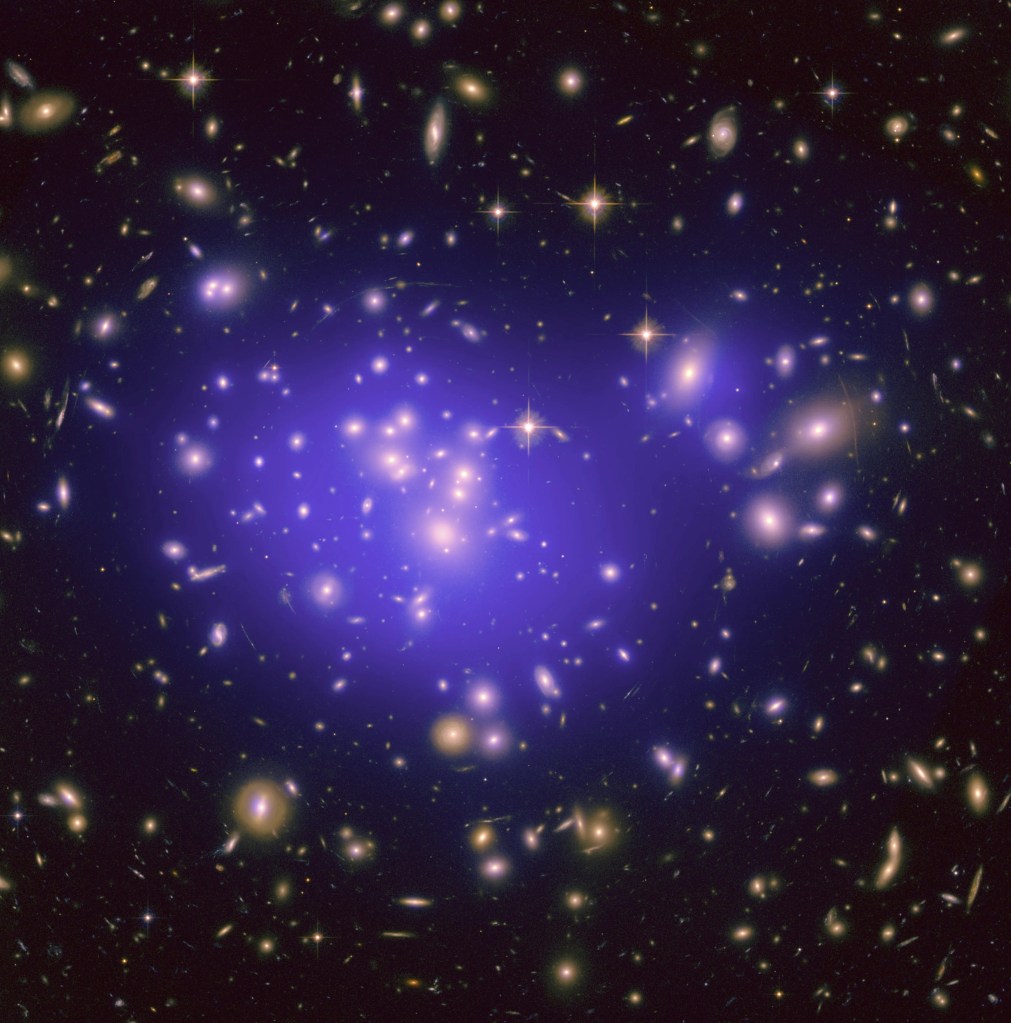
Shining a Light on Dark Matter
The gravitational pull of dark matter guides the formation of everything we can see in the universe.

Mapping the Cosmic Web
Filaments and sheets of matter create an interconnected web that forms the large-scale structure of the universe.




























